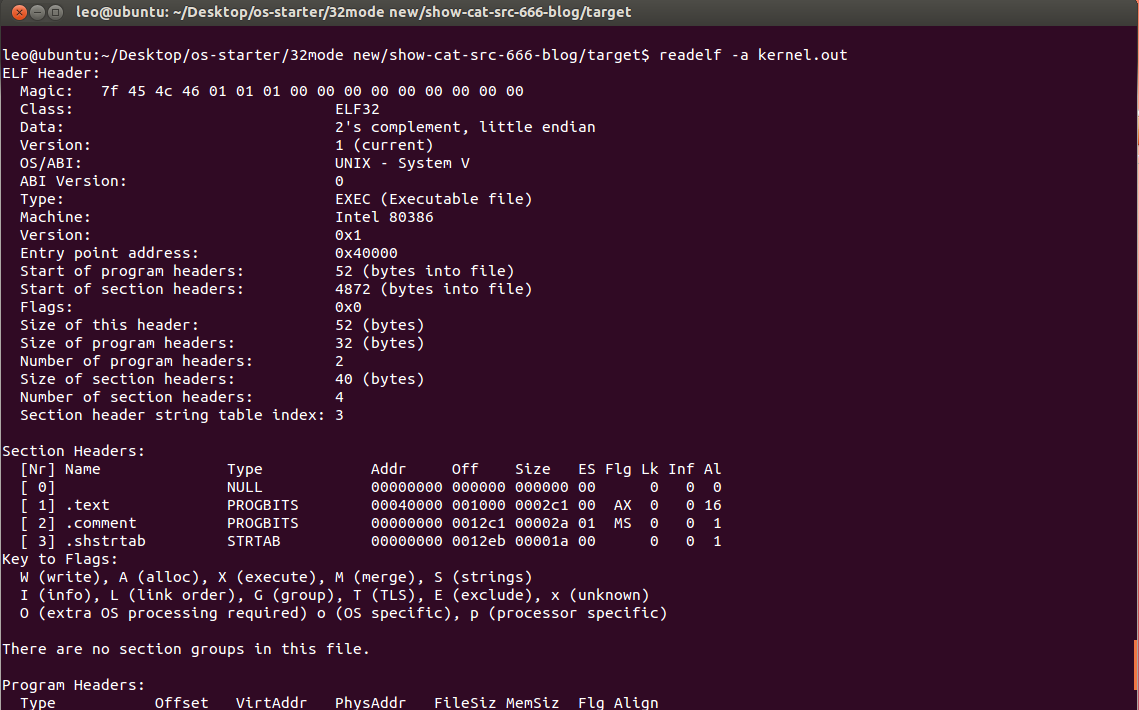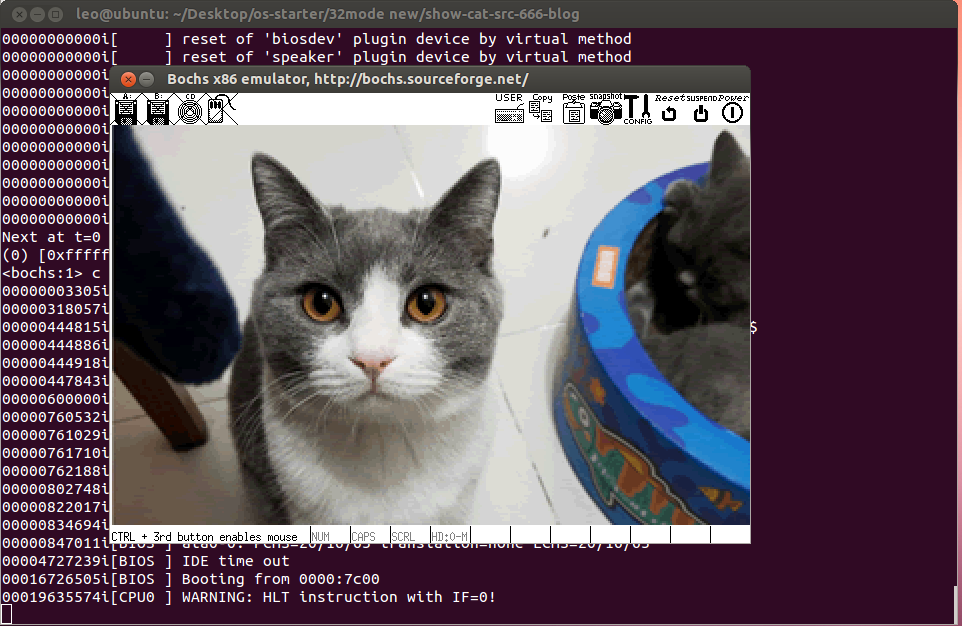1 任务
为了学习计算机底层和os,我给自己布置了一个任务:在x86硬件上,使用c和nasm来显示一张bmp图片。完成这个任务,前后估计花了2个月的业余时间。
这个任务涉及了很多知识点,包括:启动区、保护模式、nasm汇编、c和nasm汇编互调、ld链接、硬盘io读取、显卡调色板模式、bmp图片格式、bios中断指令、c指针操作内存、borch虚拟机、binutils工具集、makefile等。
2 环境
ubuntu
borchs
nasm和 c
PS:c代码遵循google的C++ 风格指南,使用gnu99标准。
3步骤
3.1 生成一个10M的硬盘镜像
bximage是borchs软件包的一个小工具,可以用于生成硬盘或软盘镜像。打开终端,输入:bximage。按照如下图所示的,一步一步地操作。

最终会在当前目录下,生成一个名为10M.img的文件。
3.2 准备一张320*200的bmp图片
为简单起见,屏幕的分辨率使用320*200。因此我们的bmp图片的大小320*200。我准备了一张图片,如下,这是我家主子的靓照。
将文件命名为cat-666.bmp,然后写入到#201扇区
dd if=src/cat-ham.bmp of=10M.img bs=512 seek=201 conv=notrunc3.3 引导区
引导区位于启动盘的#0扇区,为计算机启动后首次执行的代码。为简单起见,我们的引导区仅完成以下功能:
- 设置vga模式设置显示模式为320*200。
- 配置了配置了5个gdt表项,用作程序运行的内存空间。
- 跳入32位保护模式。
- 读取内核至内存0x100000
- 跳至内核入口。
具体代码如下:boot.asm
1 ;设置堆栈段和栈指针
2 mov eax, cs
3 mov ss, eax
4 mov sp, 0x7c00
5
6
7 set_vga:
8 mov ax, 0x0013 ;;0x0013为 320*200*8bit
9 int 0x10 ;int 0x10
10
11 set_gdt:
12 ;GDT 开始于 0x7e00
13 mov ax, 0x7e00
14 mov bx, ax;
15
16 ; null_descriptor,这是处理器的要求
17 mov dword [bx + 0x00], 0x00000000
18 mov dword [bx + 0x04], 0x00000000
19
20 ; code 启动区
21 mov dword [bx + 0x08], 0x7c0001ff ;base:0x7c00,limit: 1ff,512B
22 mov dword [bx + 0x0c], 0x00409A00 ;粒度为1B,
23
24 ; code kernel
25 mov dword [bx + 0x10], 0x000000ff ; base: 0x10_0000, limit:0xff,1MB
26 mov dword [bx + 0x14], 0x00c09a10 ; 粒度为4KB,
27
28 ; data
29 mov dword [bx + 0x18], 0x0000ffff ;base: 0, limit:0xf_ffff, 4GB
30 mov dword [bx + 0x1c], 0x00cf9200 ;粒度为4KB,
31
32 ; stack
33 mov dword [bx + 0x20], 0x7a00fffe ; base: 0x7a00, limit:0xfffe
34 mov dword [bx + 0x24], 0x00cf9600 ; 粒度为4KB,
35
36 ;初始化描述符表寄存器 GDTR
37 mov word [cs: gdt_desc + 0x7c00], 39 ;描述符表的界限
38 lgdt [cs: gdt_desc + 0x7c00]
39
40 in al, 0x92 ;南桥芯片内的端口
41 or al, 0000_0010B
42 out 0x92, al ;打开A20
43
44 cli ;中断机制尚未工作
45
46 mov eax, cr0
47 or eax, 1
48 mov cr0, eax ;设置PE位
49
50 ;以下进入保护模式 ...
51 jmp dword 0x0008: mode32_start ;16位的描述符选择子:32位偏移
52
53
54
55 [bits 32]
56 mode32_start:
57 mov eax, 0x0018 ;加载数据段选择子
58 mov es, eax;
59 mov ds, eax;
60
61
62 ; 读取内核,并且跳入。读取200个扇区至 0x10_0000
63 read_kernel:
64 mov dx, 0x1f2;
65 mov al, 200 ; 200个扇区
66 out dx, al ;
67
68 mov dx, 0x1f3 ;
69 mov al ,0x01 ; 1号扇区(第2个扇区), zero-based
70 out dx, al;
71
72 mov dx, 0x1f4 ;
73 mov al, 0x00 ;
74 out dx, al ;
75
76 mov dx, 0x1f5 ;
77 mov al, 0x00;
78 out dx, al;
79
80 mov dx, 0x1f6 ;
81 mov al, 0xe0 ;
82 out dx, al ;
83
84 ; ask for read
85 mov dx, 0x1f7 ;
86 mov al, 0x20 ;
87 out dx, al ;
88
89 ; wait for finish
90 mov dx, 0x1f7 ;
91 _rk_wait:
92 in al,dx ;
93 and al, 0x88 ;
94 cmp al, 0x08 ;
95 jnz _rk_wait ;
96
97 ;read data to bx
98 mov ebx, 0x10_0000 ;
99 mov cx, 256 * 200 ; n * 256;
100 mov dx, 0x1f0 ;
101
102 _rk_read_loop:
103 in ax, dx;
104 mov word[ebx], ax; ; 每次读2个字节
105 add ebx, 2;
106 loop _rk_read_loop ;
107
108 ; jump to kernel, 段选择子
109 jmp dword 0x0010:0
110
111
112 hlt;
113
114
115 ;-------------------------------------------------------------------------------
116 gdt_desc: dw 0
117 dd 0x00007e00 ; GDT的物理地址,刚好在启动区之后
118 ;-------------------------------------------------------------------------------
119 times 510-($-$$) db 0
120 db 0x55, 0xaa
编译
nasm boot.asm -f bin -o boot.bin
写入到硬盘镜像(写入到#0扇区)
dd if=boot.bin of=10M.img bs=512 count=1 conv=notrunc
3.4 bmp文件的结构
BMP文件格式,又称为Bitmap(位图)或是DIB(Device-Independent Device,设备无关位图),是Windows系统中广泛使用的图像文件格式。其结构如下图所示:

参考:https://www.cnblogs.com/kingmoon/archive/2011/04/18/2020097.html
参考bmp的结构定义,编写如下头文件:bmp.h
1 #ifndef _OS_BMP_H_
2 #define _OS_BMP_H_
3
4 #include <stdint.h>
5
6 typedef struct {
7 /**
8 * 文件类型,
9 */
10 char type[2];
11
12 /**
13 * 位图大小
14 */
15 uint32_t size;
16
17 /**
18 * 保留位
19 */
20 uint16_t reserved1;
21
22 /**
23 * 保留位
24 */
25 uint16_t reserved2;
26
27 /**
28 * 图像数据偏移量
29 */
30 uint32_t off_bits;
31
32 } __attribute__ ((packed)) BitMapFileHeader;
33
34 /**
35 * 信息头
36 */
37 typedef struct {
38 /**
39 * BitMapFileHeader 字节数
40 */
41 uint32_t size;
42
43 /**
44 * 位图宽度
45 */
46 uint32_t width;
47
48 /**
49 * 位图高度,正位正向,反之为倒图
50 */
51 uint32_t height;
52
53 /**
54 * 为目标设备说明位面数,其值将总是被设为1
55 */
56 uint16_t planes;
57
58 /**
59 * 说明比特数/象素,为1、4、8、16、24、或32。
60 */
61 uint16_t bit_count;
62
63 /**
64 * 图象数据压缩的类型没有压缩的类型:BI_RGB
65 */
66 uint32_t compression;
67
68 /**
69 * 图像数据区大小,以字节为单位
70 */
71 uint32_t image_size;
72
73 /**
74 * 水平分辨率
75 */
76 uint32_t x_pixel_per_meter;
77
78 /**
79 * 垂直分辨率
80 */
81 uint32_t y_pixel_per_meter;
82
83 /**
84 * 位图实际使用的彩色表中的颜色索引数
85 */
86 uint32_t color_used;
87
88 /**
89 * 对图象显示有重要影响的索引数,0都重要。
90 */
91 uint32_t color_important;
92 } __attribute__ ((packed)) BitMapInfoHeader;
93
94 /*
95 * 颜色结构体
96 */
97 typedef struct {
98 /**
99 *
100 */
101 uint8_t blue;
102
103 /**
104 *
105 */
106 uint8_t green;
107
108 /**
109 *
110 */
111 uint8_t red;
112
113 /**
114 * 保留值
115 */
116 uint8_t reserved;
117
118 } __attribute__ ((packed)) RGB;
119
120 #endif //_OS_BMP_H_
代码说明:
- 定义了3个结构体BitMapFileHeader(文件头)、 BitMapInfoHeader(位图信息头)、RGB(颜色)
- 需要特别注意的是,在类型定义中加入了__attribute__ ((packed))修饰。它的作用就是告诉编译器取消结构体在编译过程中的优化对齐,按照实际占用字节数进行对齐,是GCC特有的语法。不加入这个的话,会导致程序在读取bmp数据时发生错位。
3.5 io操作
在这个任务中需要直接操作硬件,比如读取硬盘扇区、端口读写、打开中断、读取eflags标志等,这部分功能的代码将使用nasm来编写,然后导出相应的方法让c来调用。
nasm代码如下:x86.asm
;数据区
[section .data] ;
;代码区
[section .text] ;
global read_sector;
global io_hlt ;
;
global io_in8;
global io_in16;
global io_in32;
global io_out8;
global io_out16;
global io_out32;
;
global io_read_eflags;
global io_write_eflags;
;
global io_cli;
global io_sti;
;
;功能 : 读取一个扇区
;入口 : 无
;出口 : 无
;堆栈使用: 无
;全局变量:
;函数签名:void read_sector(int sector, int dst);
read_sector:
mov ecx, [esp + 4] ;参数1:sector
mov ebx, [esp + 8] ;参数2:dst
mov dx, 0x1f2 ;
mov al, 0x01 ;1 sector
out dx, al ;
mov dx, 0x1f3 ;
mov al, cl ;0-7
out dx, al ;
mov dx, 0x1f4 ;
mov al, ch ;8-15
out dx, al
mov dx, 0x1f5 ;
mov al, 0x00 ;16-23
out dx, al ;
mov dx, 0x1f6 ;
mov al, 0xe0 ;
out dx, al ;
; ask for read
mov dx, 0x1f7 ;
mov al, 0x20 ;
out dx, al ;
; wait for finish
mov dx, 0x1f7 ;
_rs_wait:
in al, dx ;
and al, 0x88 ;
cmp al, 0x08 ;
jnz _rs_wait ;
;read data to bx
mov cx, 256 ;
mov dx, 0x1f0 ;
_rs_read_loop:
in ax, dx ;
mov word[ebx], ax ;
add ebx, 2 ;
loop _rs_read_loop ;
ret ;
;功能 : 挂起
;入口 : 无
;出口 : 无
;堆栈使用: 无
;全局变量:
;函数签名:void io_hlt(void);
io_hlt:
hlt ;
ret;
;功能 : 读取 eflags
;函数签名: int read_eflags(void);
io_read_eflags:
pushfd ;将 eflags 压入栈
pop eax ;将 eflags 弹出并保存至eax
ret
;功能 : 往端口写入1个字节
;函数签名: void io_out8(int port, int value);
io_out8:
mov edx, [esp + 4] ;参数1: port
mov al, [esp + 8] ;参数2:value
out dx, al
ret
;功能 : 从端口读取1个字节
;函数签名:uint8_t io_in8(int port);
io_in8:
mov edx, [esp + 4] ;参数1: port
mov eax, 0 ;将数据置为0,防止干扰
in al, dx ;
ret
;功能 : 从端口读取2个字节
;函数签名:uint16_t io_in16(int port);
io_in16:
mov edx, [esp + 4] ;参数1: port
mov eax, 0 ;将数据置为0,防止干扰
in ax, dx ;
ret
;功能 : 从端口读取4个字节
;函数签名:uint32_t io_in32(int port);
io_in32:
mov edx, [esp + 4] ;参数1: port
mov eax, 0 ;将数据置为0,防止干扰
in eax, dx ;
ret
;功能 : 往端口写入2个字节
;函数签名: void io_out16(int port, int value);
io_out16:
mov edx, [esp + 4] ;参数1: port
mov al, [esp + 8] ;参数2:value
out dx, ax
ret
;功能 : 往端口写入4个字节
;函数签名: void io_out32(int port, int value);
io_out32:
mov edx, [esp + 4] ;参数1: port
mov al, [esp + 8] ;参数2:value
out dx, eax
ret
;功能 : 关闭中断
;函数签名: void io_cli(void);
io_cli:
cli ; clean interrupt flag
ret
;功能 : 打开中断
;函数签名: void io_sti(void);
io_sti:
sti ; set interrupt flag
ret
;功能 : 写入 eflags
;函数签名: void write_eflags(int flags);
io_write_eflags:
mov eax, [esp + 4] ;参数1:eflags
push eax ;将参数 eflags压入栈中
popfd ;从栈中弹出eflags的值并将之写入到 EFLAGS 寄存器
ret代码说明:
- 导出函数使用global关键字。比如global read_sector,将导出read_sector函数。
- 函数的参数使用栈来存储,次序为从右到左,使用esp栈指针来访问。
- 所有的函数都放在section .text 中。
- 整型类型的返回值可以放在eax/ax/dx寄存中进行返回。
编译
nasm -f elf -o x86.o x86.asm
为了便于c代码调用上面的代码,我们还需要创建一个头文件:x86.h:
#ifndef _OS_X86_H_
#define _OS_X86_H_
#include <stdint.h>
/**
* 读取扇区的数据
* @param sector 扇区号。
* @param dst 目标地址
*/
void read_sector(int sector, uint8_t *dst);
/**
* 挂起
*/
void io_hlt();
/**
* 读取 eflags
* @return
*/
uint32_t io_read_eflags();
/**
* 写入 eflags
* @param flags
*/
void io_write_eflags(uint32_t flags);
/**
* 从端口读取1个字节
* @param port 端口号
* @return 端口上的数据
*/
uint8_t io_in8(uint16_t port);
/**
* 从端口读取2个字节
* @param port 端口号
* @return 端口上的数据
*/
uint16_t io_in16(uint16_t port);
/**
* 从端口读取4个字节
* @param port 端口号
* @return 端口上的数据
*/
uint32_t io_in32(uint16_t port);
/**
* 往端口写入1个字节
* @param port 端口号
* @param value 要写入的值
* @return
*/
void io_out8(uint16_t port, uint8_t value);
/**
* 往端口写入2个字节
* @param port 端口号
* @param value 要写入的值
* @return
*/
void io_out16(uint16_t port, uint16_t value);
/**
* 往端口写入4个字节
* @param port 端口号
* @param value 要写入的值
* @return
*/
void io_out32(uint16_t port, uint32_t value);
/**
* 关闭中断
*/
void io_cli();
/**
* 打开中断
*/
void io_sti();
#endif //_OS_X86_H_
代码说明:
- 函数的签名要跟nasm文件中的保持一致,包括函数名,参数个数、参数类型。
- 在调用的时候跟普通的头文件一样,先引入x86.h,然后调用相应的方法。
3.6 内核代码
在内核代码中,执行以下操作:
- 读取bmp文件所在的起始个扇区。从该扇区数据中取出文件大小,决定要还要继续读几个扇区,接着读完所有扇区。
- 从bmp数据中取出调色板数据,然后用它来更改显卡的调色板。
- 从bmp数据中取出图像数据,写入到图像缓冲区。
代码如下:kernel.c
1 #include <stdint.h>
2 #include "x86.h"
3 #include "bmp.h"
4
5 // 视频缓冲区的内存位置
6 #define VIDEO_BUFFER_MEMORY_LOC 0x0a0000
7 // bmp文件的内存位置
8 #define BMP_FILE_MEMORY_LOC 0x200000
9 // bmp文件所在的起始扇区
10 #define BMP_FILE_SECTOR 201
11
12 int main(void) {
13 // 读扇区的索引,
14 uint32_t sector_read_index = BMP_FILE_SECTOR;
15 // 读文件的索引
16 uint8_t *file_read_index = (uint8_t *) BMP_FILE_MEMORY_LOC;
17
18 // 读取bmp文件所在的第1个扇区
19 read_sector(sector_read_index, file_read_index);
20 file_read_index = file_read_index + 512;
21 sector_read_index++;
22
23 // 文件头
24 BitMapFileHeader *bmp_header = (BitMapFileHeader *) BMP_FILE_MEMORY_LOC;
25 uint32_t file_size = bmp_header->size;
26
27 // 图像数据偏移
28 uint32_t off_bits = bmp_header->off_bits;
29
30 // 需要再读取几个扇区?
31 int more_sectors = (file_size / 512) - 1;
32 if (file_size % 512 != 0) {
33 more_sectors++;
34 }
35
36 // 读取更多扇区
37 for (int i = 0; i < more_sectors; i++) {
38 read_sector(sector_read_index, file_read_index);
39 sector_read_index++;
40 file_read_index += 512;
41 }
42
43 //*********************调色板设置 *************
44 // 读取调色板数据
45 // 调色板数据开始于文件偏移 54
46 RGB *palette_index = (RGB *) (BMP_FILE_MEMORY_LOC + 54);
47 //
48 uint32_t eflags = io_read_eflags();
49 io_cli();
50
51 // 写入0号调色板
52 io_out8(0x03c8, 0);
53
54 // 写入调色板数据
55 for (int i = 0; i < 256; ++i) {
56 RGB rgb = *palette_index;
57 // 必须除以4,因为 vga 只能显示64色
58 io_out8(0x03c9, rgb.red / 4);
59 io_out8(0x03c9, rgb.green / 4);
60 io_out8(0x03c9, rgb.blue / 4);
61 palette_index++;
62 }
63
64 io_write_eflags(eflags);
65
66 // 位图信息头
67 BitMapInfoHeader *info_header = (BitMapInfoHeader *) (BMP_FILE_MEMORY_LOC + 14);
68 // 数据位数组
69 uint8_t *file_bits = (uint8_t *) (BMP_FILE_MEMORY_LOC + off_bits);
70 // 坐标点的内存地址
71 uint8_t *p = 0;
72 //
73 for (int i = 0; i < info_header->image_size; i++) {
74 // x 坐标
75 int x = i % info_header->width;
76 // y 坐标
77 int y = (info_header->height - 1) - (i / info_header->width);
78 // 点(x,y)的内存地址
79 p = (uint8_t *) (VIDEO_BUFFER_MEMORY_LOC + x + y * info_header->width);
80 *p = *file_bits;
81 file_bits++;
82 }
83
84 // use this to avoid to reset
85 while (1) {
86 io_hlt();
87 }
88 return 0;
89 }
关键代码说明:
- 在写入调色板之前,eflags要先暂存,然后再回写。
- bmp的数据是从下往上,从左往右存储的,所以显示的时候要反过来。
- 对视频缓冲区内存区域的读写用到了指针。定义一个指针uint8_t *p, p为坐标点的内存地址,然后使用*p = *file_bits来修改该内存的值。
编译
gcc -c-std=gnu99 -fno-stack-protector -m32 -Wall -o kernel.o kernel.c
3.7 链接
链接脚本如下:kernel.ld
1 OUTPUT_FORMAT("elf32-i386")
2 OUTPUT_ARCH(i386)
3 ENTRY(main)
4
5 SECTIONS
6 {
7 . = 0x040000;
8 .text : {
9 *(.text)
10 }
11 .data : {
12 *(.data)
13 }
14 .bss : {
15 *(.bss)
16 }
17 /DISCARD/ : {
18 *(.eh_frame .note.GNU-stack)
19 }
20 }
21
22
脚本说明:
- OUTPUT_FORMAT("elf32-i386") 表示输出格式为efl32 32位格式。
- ENTRY(main) 表示入口函数为main
- /DISCARD/表示忽略.eh_frame段和.note.GNU-stack
链接
ld -s -T kernel.ld -o kernel.out kernel.o x86.o
注意,对象文件(*.o)的次序要正确,否则运行的时候会出错。次序的原则是被依赖的放在后面。
3.8 .text段提取
链接后的文件kernel.out是一个elf类型的文件,它包含了elf头信息、.text、.data等。通过readelf命令可以查看efl文件的结构。
readelf -a kernel.out命令结果如下:

我们仅需要 .text段 。这个时候通过objcopy来提取kernel.out中的.text段,如下:
objcopy -S -O binary -j .text kernel.out kernel.bin
将kernel.bin写入到硬盘镜像(从#1扇区开始)
dd if=target/kernel.bin of=10M.img bs=512 seek=1 count=200 conv=notrunc
3.9 放入borch虚拟机中运行
配置一个虚拟机,配置如下,bochsrc :
1 ###############################################################
2 # Configuration file for Bochs
3 ###############################################################
4
5 # how much memory the emulated machine will have
6 megs: 32
7
8 # filename of ROM images
9 romimage: file=/usr/local/share/bochs/BIOS-bochs-latest
10 vgaromimage: file=/usr/local/share/bochs/VGABIOS-lgpl-latest
11
12 # what disk images will be used
13 #floppya: 1_44=a.img, status=inserted
14 ata0-master: type=disk, mode=flat, path="10M.img", cylinders=20, heads=16, spt=63
15
16 # choose the boot disk.
17 #boot: floppy
18 boot: disk
19
20
21 # where do we send log messages?
22 # log: bochsout.txt
23 # disable the mouse
24 mouse: enabled=0
25
26 # enable key mapping, using US layout as default.
27 keyboard_mapping: enabled=1, map=/usr/local/share/bochs/keymaps/x11-pc-us.map
28
29
关键配置说明:
- megs: 32 表示内存为32M
- boot: disk 表示从硬盘启动
- ata0-master: path="10M.img", 设置了硬盘镜像的路径
- vgaromimage: file=VGABIOS-lgpl-latest 表示显卡的rom镜像为VGABIOS-lgpl-latest,如果设置错误,显示就会不正常。
- keyboard_mapping: enabled=1, 用于设置键盘布局,这里采用美式键盘布局。
启动虚拟机
bochs -q
效果如下:

3.10 makefile
用makefile将上面零散的命令整合一下。脚本如下,Makefile:
1 .PHONY : all clean run install
2
3 CFLAGS = -std=gnu99 -fno-stack-protector -m32 -Wall
4
5 all: target/boot.bin target/kernel.bin install
6
7 target/boot.bin : src/boot.asm
8 nasm src/boot.asm -f bin -o target/boot.bin
9
10 target/kernel.bin : target/kernel.out
11 objcopy -S -O binary -j .text target/kernel.out target/kernel.bin
12
13 target/x86.o : src/x86.asm
14 nasm -f elf -o target/x86.o src/x86.asm
15
16 target/kernel.o : src/kernel.c
17 gcc -c $(CFLAGS) -o target/kernel.o src/kernel.c
18
19 # x86.o要放到最后,否则会无法运行
20 target/kernel.out : target/kernel.o target/x86.o
21 ld -s -T kernel.ld -o target/kernel.out target/kernel.o target/x86.o
22
23
24
25 install :
26 # #0扇区
27 dd if=target/boot.bin of=10M.img bs=512 count=1 conv=notrunc
28 # #1 ~ #200 扇区
29 dd if=target/kernel.bin of=10M.img bs=512 seek=1 count=200 conv=notrunc
30 # #201扇区开始
31 dd if=src/cat-666.bmp of=10M.img bs=512 seek=201 conv=notrunc
32
33
34 run :
35 make all
36 bochs -q
37
38
39 clean :
40 -rm target/*.bin
41 -rm target/*.o
42 -rm target/*.out
43
44
45
46 脚本说明:
- 将源文件放到src目录下,将目标文件放到target目录下。
- make run 为运行。
- make install 为安装。
- make clean 为清理。
3.11 内存和硬盘布局
内存布局
| 物理地址 |
内容 |
| 0x7c00 ~ 0x7dff |
启动区 |
| 0x7e00~ 0x7eff |
gdt |
| 0x100000~0x1fffff |
内核,大小1M。 |
| 0x200000开始 |
图片。 |
| 0x0a0000-0xaf9ff |
图像缓冲区 |
硬盘布局
| 扇区 |
内容 |
| #0 |
boot.bin |
| #1 ~ #200 |
kernel.bin |
| #201 |
cat-6666.bmp |
4 参考资料
- 《x86汇编语言 从实模式到保护模式》
- 《Linux0.11内核完全注释》
- 《30天自制操作系统》
- 《一步一步学习linux汇编语言程序设计》
- 《xv6》
来源:oschina
链接:https://my.oschina.net/u/4265788/blog/4404565
